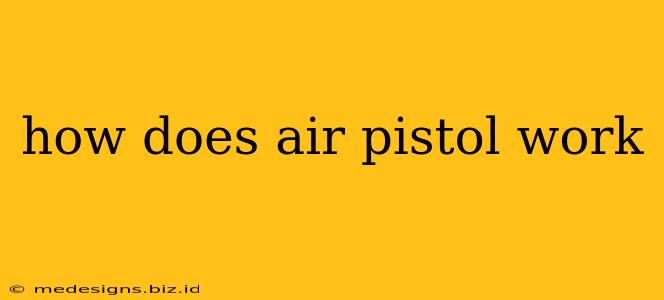How Does an Air Pistol Work? A Comprehensive Guide
Air pistols, popular for target shooting, sport, and even pest control, operate on compressed air to propel projectiles. Understanding their mechanics is crucial for safe and effective use. This guide delves into the inner workings of these fascinating devices.
Types of Air Pistols and Their Mechanisms
Before diving into the specifics, it's essential to understand that air pistols come in several varieties, each with its own operating principle:
-
Spring-Powered Air Pistols: These are the simplest type. A powerful spring compresses when you cock the pistol. Releasing the trigger releases the spring, which drives a piston that compresses air in a chamber. This compressed air then propels the pellet or BB forward. They're generally less powerful than other types but are inexpensive and easy to maintain. Think of it like a miniature version of a spring-loaded catapult.
-
CO2 Air Pistols: These use small carbon dioxide (CO2) cartridges as their power source. The CO2, under pressure, expands rapidly when released, pushing a pellet or BB down the barrel. CO2 pistols offer more consistent power and higher velocity than spring-powered models. The pressure remains consistent until the CO2 cartridge is depleted.
-
Pre-Charged Pneumatic (PCP) Air Pistols: These are the most sophisticated type. They require an external air compressor or scuba tank to fill a high-pressure air reservoir within the pistol. This reservoir provides air for multiple shots without needing to reload or re-cock after each shot. PCP pistols offer superior accuracy and consistency, especially at longer ranges. Think of it as a miniaturized air rifle with a built-in, high-pressure tank.
The Shared Mechanics of Air Pistol Operation
Regardless of the power source, all air pistols share some fundamental operational features:
-
The Barrel: This is the smooth-bore tube through which the projectile travels. Its length and internal condition significantly impact accuracy and velocity.
-
The Chamber: This is where the compressed air is stored before propelling the projectile. In spring-powered pistols, this is a part of the piston mechanism; in CO2 pistols, it's within the cartridge itself; and in PCP pistols it's the high pressure reservoir.
-
The Valve: This controls the release of compressed air into the barrel. Its precise timing and function are crucial for consistent shot power and accuracy.
-
The Trigger Mechanism: This is responsible for initiating the release of the compressed air. It's designed for safe handling and trigger control.
-
The Hammer (or Striker): This part strikes the valve (in spring and CO2 models), initiating the air release.
Safety Precautions: Handling Air Pistols Responsibly
Air pistols, while fun and engaging, require responsible handling:
- Always treat every air pistol as if it were loaded.
- Never point the pistol at anything you don't intend to shoot.
- Keep your finger off the trigger until you're ready to fire.
- Store air pistols unloaded and in a safe place, out of reach of children.
- Wear appropriate eye and ear protection when shooting.
- Familiarize yourself with local laws and regulations regarding air pistol ownership and use.
Conclusion: Understanding the Power Behind the Shot
This guide provides a comprehensive overview of how air pistols function. Understanding these mechanics, combined with a strong emphasis on safety, allows for enjoyable and responsible participation in this popular activity. Remember, proper knowledge and safe handling practices are paramount when dealing with any type of firearm, even air-powered ones.
